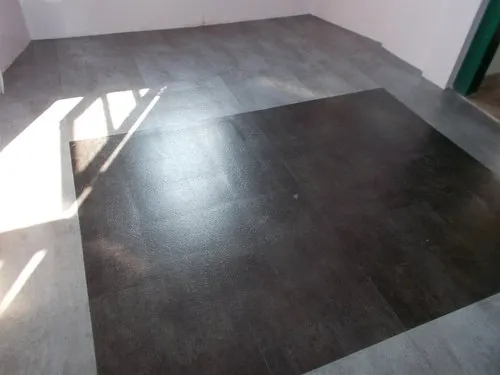Vinyl Floor Tiles, For Office, Thickness: 1.5mm To 3mm
₹65.0
Product Specification
| Material | Vinyl |
| Thickness | 1.5mm to 3mm |
| Usage/Application | Office |
| Size | 18″ x 18″, 24″ x 24″, 36″ x 36″ |
| Color | Multi |
| Plank Wood Packaging | Depend on Thickness |
| Minimum Order Quantity | 30 Square Feet |
Product Description
Offered by us in numerous patterns, designs, shades and combinations; these offered flooring are highly durable in nature and thus are enormously
accepted in the industry.
DESCRIPTION
This highly durable vinyl flooring material can be used to give the look of real wood planks at indoors and temperature controlled environments.
Luxury Vinyl planks reflects the characteristics of wood and are available in artful striking shades.
It is considerably less sensitive, more hygienic and easier to clean than the original materials like wood.
Moreover, these design planks are hard-wearing and durable.
Look like wood, feel like wood and last longer than wood
FEATURES
Low cost
Easy maintenance
Hygienic and versatile
Heavy-duty usage
Multiple Thickness options (1.5,2,3)
VOC compliant
No – rotten
Waterproof
Termites free
Non –formaldehyde
Looks luxurious and cozy
Highly Durable
Flame Retardant
Slip Resistant
Cleaning Agent Free
Easy to Clean
Bacteria Free
Easy Maintenance & Installation at Economical price
Various colours and unique patterns
Further, the planks are underfoot, easy to installMAINTENANCE:
Daily – Vacuuming, sweeping and dust mopping
100% synthetic so it does not affect by water or moisture.
For cleaning you can wash or slight mop daily to remove dirt and grit.
Re-polishing is not required after many years.
Stable colours and do not get fade easily.
Does not easily get scratches while dragging furniture and wheel chairs.APPLICATION
Retail, Hospitality, Education, Health and Aged Care, Residential
- Description
- Additional information
- Reviews (0)
- Q & A
- Sustainability Remark
- More Offers
- Store Policies
- Inquiries
| Color | MultiColor |
|---|---|
| Material | Vinyl |
| Size | 18" x 18", 24" x 24", 36" x 36" |
You must be logged in to post a review.
Q & A
Low VOC Flooring:
Low VOC (volatile organic compounds) flooring is designed to minimize the release of harmful chemicals into the air, which can contribute to indoor air pollution and have negative health effects. It is considered more sustainable compared to traditional flooring options that may contain high levels of VOCs.
The sustainability of low VOC flooring depends on several factors:
Health and Environmental Impact: Low VOC flooring reduces indoor air pollution, which can benefit the health of occupants. It also minimizes the release of harmful chemicals into the environment during manufacturing, use, and disposal.
Material Selection: The sustainability of low VOC flooring depends on the materials used. Opting for natural, renewable, or recycled materials can enhance its sustainability. Examples include bamboo, cork, reclaimed wood, or recycled rubber.
Manufacturing Processes: Sustainable manufacturing practices, such as energy efficiency, waste reduction, and use of eco-friendly production methods, contribute to the overall sustainability of low VOC flooring.
Durability and Lifespan: Longer-lasting flooring materials reduce the need for replacement and waste generation. Choosing durable low VOC flooring options can enhance sustainability by reducing resource consumption and waste generation.
Disposal and End-of-Life Options: Sustainable flooring should consider end-of-life options such as recycling or proper disposal to minimize environmental impact. Some low VOC flooring materials can be recycled, repurposed, or safely disposed of at the end of their life cycle.
Water-Efficient Plumbing:
Water-efficient plumbing systems aim to minimize water waste by reducing consumption without compromising functionality. They contribute to sustainability in several ways:
Conservation of Water Resources: Water-efficient plumbing fixtures, such as low-flow toilets, showerheads, and faucets, reduce the amount of water used for daily activities. This helps conserve water resources, especially in areas facing water scarcity or experiencing droughts.
Energy Savings: Reducing water usage also leads to energy savings. Water treatment, distribution, and heating require energy, so by conserving water, energy consumption associated with water use is reduced.
Cost Savings: Water-efficient plumbing can result in lower water bills for individuals and businesses. By reducing water consumption, expenses related to water supply and wastewater treatment can be significantly reduced.
Reduced Strain on Infrastructure: Water-efficient plumbing can alleviate strain on water and wastewater infrastructure by reducing demand. This can delay the need for expensive infrastructure expansion or upgrades, leading to cost savings and lower environmental impact.
Environmental Benefits: Water-efficient plumbing reduces the need to extract, treat, and distribute water, thereby reducing the environmental impact associated with these processes. It also helps minimize wastewater generation and the energy required for wastewater treatment.
To enhance the sustainability of water-efficient plumbing, it is crucial to combine it with other sustainable practices, such as rainwater harvesting, graywater recycling, leak detection, and education on responsible water use.
Overall, both low VOC flooring and water-efficient plumbing contribute to sustainable living by reducing environmental impact, conserving resources, and promoting healthier indoor environments.
General Inquiries
There are no inquiries yet.



Reviews
There are no reviews yet.